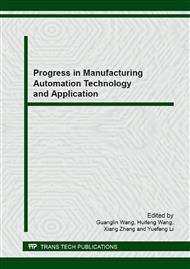p.181
p.186
p.192
p.197
p.202
p.211
p.216
p.220
p.224
Finite Element Simulation on High Speed Cutting of Hardened 45 Steel Based on ABAQUS
Abstract:
For the high speed cutting process of hardened 45 steel (45HRC), a finite element simulation of cutting deformation, cutting force and cutting temperature is finished with the large general finite element software ABAQUS. Through the building of geometry model, material model and heat conduction model, also the determination of boundary conditions, separation rule and friction condition, a thermal mechanical coupling finite element model of high speed cutting for hardened 45 steel is built. The serrated chip, cutting force and cutting temperature can be predicted. The comparison of experiment and simulation shows the validity of the model. The influence of cutting parameters on cutting process is investigated by the simulation under different cutting depthes and rake angles. The results show that as the increase of rake angle, the segment degree, cutting force and cutting temperature decrease. But the segment degree, also the cutting force and cutting temperature increase with the increase of cutting depth. This study is useful for the selection of cutting parameters of hardened steel.
Info:
Periodical:
Pages:
202-207
Citation:
Online since:
September 2013
Authors:
Price:
Сopyright:
© 2014 Trans Tech Publications Ltd. All Rights Reserved
Share:
Citation:


